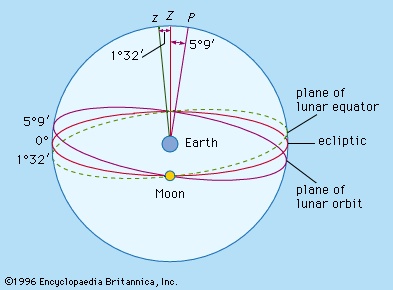Cassini's laws
astronomy
 three empirical rules that accurately describe the rotation of the Moon, formulated in 1693 by Gian Domenico Cassini. They are: (1) the Moon rotates uniformly about its own axis once in the same time that it takes to revolve around the Earth; (2) the Moon's equator is tilted at a constant angle (about 1°32′ of arc) to the ecliptic, the plane of Earth's orbit around the Sun; and (3) the ascending node of the lunar orbit (i.e., the point where the lunar orbit passes from south to north on the ecliptic) always coincides with the descending node of the lunar equator (i.e., the point where the lunar equator passes from north to south on the ecliptic). As a consequence of the third law, the north pole of the Moon as projected on the sky (point z), the north pole of the ecliptic (point Z), and the north pole of the lunar orbit (point P, inclined at an angle of about 5°9′ to the ecliptic) all lie close to one another on a great circle.
three empirical rules that accurately describe the rotation of the Moon, formulated in 1693 by Gian Domenico Cassini. They are: (1) the Moon rotates uniformly about its own axis once in the same time that it takes to revolve around the Earth; (2) the Moon's equator is tilted at a constant angle (about 1°32′ of arc) to the ecliptic, the plane of Earth's orbit around the Sun; and (3) the ascending node of the lunar orbit (i.e., the point where the lunar orbit passes from south to north on the ecliptic) always coincides with the descending node of the lunar equator (i.e., the point where the lunar equator passes from north to south on the ecliptic). As a consequence of the third law, the north pole of the Moon as projected on the sky (point z), the north pole of the ecliptic (point Z), and the north pole of the lunar orbit (point P, inclined at an angle of about 5°9′ to the ecliptic) all lie close to one another on a great circle. - Ron Howard
- Ronne, Finn
- Ronne Ice Shelf
- Ron Paul
- Ronsard, Pierre de
- Ronstadt, Linda
- Roodepoort
- rood screen
- roof
- roof pendant
- rook
- Rookes Evelyn Bell Crompton
- Roon, Albrecht Theodor Emil, Graf von
- Rooney, Mickey
- Roosa, Stuart A.
- Roosendaal
- Roosevelt, Edith
- Roosevelt, Eleanor
- Roosevelt, Franklin D.
- Roosevelt Island
- Roosevelt, Theodore
- Roosevelt University
- Roos, S.H. de
- roosterfish
- root